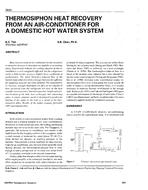-
-
Available Formats
- Options
- Availability
- Priced From ( in USD )
-
Available Formats
-
- Immediate download
-
$16.00Members pay $7.00
- Add to Cart
Customers Who Bought This Also Bought
-

3645 -- Thermosiphon Heat Recovery From an Air Conditione...
Priced From $16.00 -

3622 -- Influence of the Expansion Device on Air Conditio...
Priced From $16.00 -

3648 -- Two-Dimensional Natural Convection over the Isoth...
Priced From $16.00 -

3661 -- Simulation of Performance of Chlorine-Free Fluori...
Priced From $16.00
About This Item
Full Description
A test facility was constructed to measure the pressure-temperature-concentration relations for mixtures of dichlorofluoromethane (R12) and two mineral oils and tetrafluoroethane (R134a) and two synthetic oils. Baseline data were collected for mixtures of R12/naphthenic mineral oil and R12/paraffinic mineral oil at concentrations from 1% to 100% R12 (by mass) over the temperature range of -50 deg F (-46 deg C) to 250 deg F (121 deg C). Data were also collected for mixtures of R134a/polyalkylene glycol (PAG) and R134a/ester-based oil at concentrations from 5% to 100% R134a over the same temperature range. These were used to develop empirical relations to predict the solubility behaviour of these refrigerant-oil mixtures. Idealised enthalpies for refrigerant-oil mixtures were calculated from pure component enthalpies. These enthalpy equations, along with the empirical pressure-temperature-concentration models, were used to theoretically determine ideal evaporator capacities for each mixture at three lubricant concentrations - 1%, 5% and 10%. Assuming standard operating conditions and neglecting pressure drop in the evaporator, significant reductions in evaporator capacities were predicted due to the increase in saturation temperature resulting from the presence of oil. The effects of oil solubility on evaporator capacity reduction were greater for systems containing R12/mineral oil mixtures than those containing R134a/synthetic oil mixtures.
KEYWORDS: lubricants, evaporators, capacity, mixtures, refrigerants, R12, R134a, oils, testing, measuring, pressure, temperature, content, calculating, heat content, saturation temperature, fluorocarbons.





